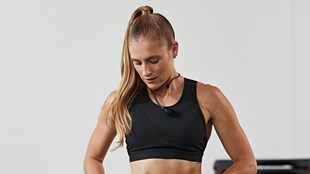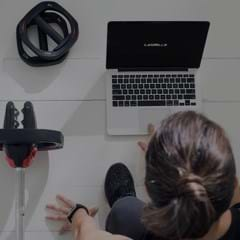1. GET YOURSELF IN THE RIGHT MINDSET
It all begins with your state of mind. How are you going to show up to your first class back?
“I pictured everyone’s faces, and the laughs that we would have in class,” says Program Director Rach Newsham. “I mentally rehearsed the whole process and that got me excited about being back in the club!”
“Initially it might feel strange, but once you accept it and allow it to be, everything works better with you and for you,” says Auckland Instructor Tommi Wong. “You have to learn to let it flow and get yourself in the right mindset first, so you can lead the members and create a safe and empowering place for them.”
2. DO YOUR HOMEWORK
After an extended period of not teaching live classes, you may need to spend extra time preparing the class so you can show up with confidence. And take heart, even the Program Directors get nervous for their first class back!
“Being totally honest I was quite nervous for my first class back,” says Creative Director Kylie Gates. “I actually interpreted this as a good thing – that even after teaching for all this time, I still really care. My preparation for this class was thorough and I didn’t leave any stone unturned. I learned the choreo (music and moves) super well as I knew this would free me up to be able to fully connect with the participants.”
“I was genuinely quite nervous,” agrees BODYJAM® Program Director Gandalf Archer Mills. “Whenever I get on stage after having a break, I like to just acknowledge to my class that I am feeling rusty. I like to say, ‘let’s find out if I can still teach dance!’.”
If you are teaching a class that’s been modified to comply with physical distancing (like BODYATTACK™), consider what changes you will need to make before you teach the class.
“In retrospect, I probably would have spent more time on preparing for the changes,” says Christchurch Trainer Bevan James Eyles. “I did do some preparation but I probably could have spent more time considering: what do I need to do to keep people on the spot? I also would have practised the tracks a few more times. I had an idea of how things would go, but when it came to being in the moment, it consumed a lot more of my headspace than I had anticipated.”
“I pictured everyone’s faces, and the laughs that we would have in class. I mentally rehearsed the whole process and that got me excited about being back in the club!” – Rachael Newsham
3. GET YOUR BODY READY
“You've got to warm up, you've got to spend two days, three days, getting your body prepared because you don't want to go into that cold and getting an injury,” says Gandalf. “You don't want to be pulling your hamstring on your first class back. You don’t want to have not exercised and then turn up to all these people in front of you who want you to go 100%! You need to physically prepare yourself for that.
“I stretched and stretched and did some lower body training the day before and some upper body stabilization work the morning of. It just meant that my knees and my legs and my back were all in a better place to get to the stage. Then before my class, I stretched for about half an hour and rode the bike for ten minutes just to get the blood flowing. It meant that when I got on stage my body was way more prepared for the oncoming onslaught that it was about to receive from dancing again after not teaching BODYJAM live for seven weeks.”
It was a similar story for Auckland Instructor Lliam Dermott. “I had to teach LES MILLS GRIT Strength™ as my first class back, so I decided a few days beforehand to put a GRIT release on and just do it,” he says.. “I died and was super thankful for the phone call I received from my mum 20 minutes into the workout… I saw it as an opportunity to give the body a little taster as to what was to come, and in the days after the first class back I didn’t feel too sore.”
4. ACCEPT THAT PHYSICAL DISTANCING WILL FEEL WEIRD
In the Les Mills clubs in New Zealand, markers were placed on the studio floor to indicate where people should stand, and the stationary bikes were separated by two meters.
“The first few days, people were uncomfortable,” says Auckland Trainer Giles Bryant. “Smiles were less frequent and there was a sense of unease in the room. After a few days and we saw how things worked and people gained confidence that our measures were good and they were safe – it flipped! People became SO happy to be in the building and seeing other people that the vibe was incredibly positive.”
“It was WEIRD!” adds Rach. “It felt a bit military – or like being back in school in PE. Everyone standing on a marker – focused on not breaking rules by getting too close – they didn’t want to be the reason the gym got shut down! It made the atmosphere really strange. People were much quieter in BODYCOMBAT™ than normal.”
“It was really strange,” agrees Auckland Instructor Sarah Ostergaard. “For me, teaching is about the connection I have with the class. Our studio has 100 bikes normally and so having the bikes two meters apart decreased the number by over half! It meant I had to adjust my teaching as there was less of the sense of inclusivity that normally comes from having lots of people close together.”
Fellow cycle Instructor Chris Richardson adds: “My first class back was THE TRIP™ and once the class started, it felt really weird. There wasn’t the usual vibe and when I turned around, rather than seeing the usual tightly-grouped pack, everyone was widely spaced out.”
“I love the analogy that we Instructors want to be like the dog in somebody’s life, and what I mean by that is: a dog is always happy to see you. When our members come back into the gym we want to be pleased to see them.” – Bevan James Eyles
5. THINK ABOUT HOW YOUR MEMBERS WILL BE FEELING
There may be mixed emotions in the room. Some will no doubt be thrilled to be back in the gym and raring to go; others might be concerned about their fitness and may be apprehensive about the risk to their health of exercising with others.
“Over the lockdown period, I had calls with some of our more senior members, and I therefore knew that some were apprehensive about coming back to the gym,” says Les Mills Auckland City GFM Susan Renata. “I put my empathy eyes on and came from a place of reassurance and welcoming for my first class back. It wasn’t about smashing the workout or everything being a challenge, but rather being a bit more gentle. When I asked in one of my classes ‘Who got fitter over lockdown?’ About 20 percent of the room put their hands up.”
Giles agrees. “I focused on what my participants were thinking and feeling coming back into the club. As a result I shifted my focus and mentality from one of seeking to help my participants to achieve their best effort and results into one of making them feel welcome, safe and accepted. That last part was really important. People are feeling very uncomfortable and any time we can make them feel less so, this is a small win for us as group fitness Instructors.”
“Lots of our members were excited to be back seeing their friends, doing a workout together and generally grateful to be back into a routine,” says Auckland Instructor Lliam Dermott. “However, there were some who needed reassurance around their fitness and how much they should do coming back. SMARTSTART has been an awesome tool to use to help them build confidence.”
Chris agrees: “Remind people that now is not the time to push too hard. Allow them to take their time and give themselves as long as they need to get back into fitness (especially if they haven’t been doing much).”
6. CONNECTION IS MORE IMPORTANT THAN EVER
After a prolonged period of exercising by yourself, it might feel slightly strange to be leading a class again and creating a connection. “Maybe halfway through [my first class] I realised I was not connecting like I usually would,” says Chris. “I was self-focused, and whilst internally I was having a great time, I was not recognising the room. It was definitely reflective of my workouts over lockdown – individual, internal, no communication with anyone. I recognised the moment, called myself out in front of the class, and we all had this light-hearted moment – I found out after class that many of the members were feeling the same – how do we actually behave in this new environment?”
“Connection at the highest level is going to be so important at this time,” says Bevan. “As humans, it’s natural to want to belong and many people come to the gym to get that sense of belonging. I love the analogy that we Instructors want to be like the dog in somebody’s life, and what I mean by that is: a dog is always happy to see you. When our members come back into the gym we want to be pleased to see them. I make sure that when I walk around the gym I’m saying, ‘How you going, how was the lockdown?’ even to people who don’t come to my classes. We want them to feel really welcomed and know that we love them being here. If we can create that sense of belonging and the sense of connectedness to the gym then yes it’s valuable to the gym but it also makes the members feel special and helps them to get back into an exercise routine.
“Even with physical distancing in place, I still really focused on having that shared experience. Since we couldn’t have physical proximity I still made sure we did things like virtual high fives, turning to person next to you, having fun in the workout. These little things are really important because going to the gym and joining in a class is often the highlight of someone’s day. I wanted to make the experience feel as normal as possible so I focused really hard on creating connection by using people’s names and all those great connection tools we have.”
“My big piece of advice for all Instructors coming back is to take extra care of their voice and avoid going too hard too soon!” – Giles Bryant
7. THINK ABOUT WHAT YOU SAY
“I had to be aware of the things I said and how that might have a different impact given how the state of the country was feeling,” says Rach. “Nervous, scared, anxious, lonely… I tried to keep all this front of mind and then send them encouragement and distraction – and be the escape that they needed, or in fact the reassurance.”
“The main thing I changed was my language around motivation,” adds Giles. “I was more gentle and inclusive in allowing everyone to just do their thing. This is something I do regularly anyway, but I was more emphatic and explicit about it when we first came back.”
To prepare for her first BODYBALANCE™/BODYFLOW® class back, Kylie says: “I went through my coaching focuses and what I wanted to coach in Layer 1 setting up of the poses. I purposely didn’t prepare any Layer 3 cues because I wanted to allow the ‘space’ to express from my heart, especially with everything going on in the world.”
8. IT MIGHT BE A PHYSICAL SHOCK TO YOUR BODY…
No matter how much training you’ve done over lockdown, returning to teach a live class is always physically demanding.
“I trained a lot over lockdown and taught live stream classes but the physical output of a live class was immense and something that is hard to train for,” says Program Director Glen Ostergaard. “My first class back was LES MILLS SPRINT™ which was a hard class to teach straight up after lockdown. I definitely worked hard that day!”
“I didn't have that constant requirement for maximum physical performance that I normally do with teaching,” says Gandalf. “In live classes your body is performing at a different level. And I didn't get there, obviously, in seven weeks of lockdown.”
“I had been able to maintain a basic exercise routines during lockdown,” says Giles. “Nonetheless, it’s always an adjustment moving from personal exercise to leading workouts. Be prepared to be sore!”
“Acknowledge what we’ve been through but don’t dwell on it. Inspire and motivate the class and be prepared that people will have a lower level of fitness or strength, knowing it will come back in a few weeks. Have fun!” – Glen Ostergaard
9. ...AND YOUR VOICE
“Of course some muscles were sore but the one thing that was the least prepared for coming back? My voice!” says Giles. “It’s super hard to train your voice when you cannot teach so my big piece of advice for all Instructors coming back is to take extra care of their voice and avoid going too hard too soon!”
Chris agrees, “My voice was weak and probably the most under-utilized muscle over the lockdown. It took a few days to recover.”
“In my first class back, I felt my voice not keeping up with the class,” says Gandalf. “Halfway through, it noticed it being weaker and starting to hurt. It kind of went away over the next few days. And then the next class I went to teach my voice was fine again.
“I've had voice issues in the past from teaching. This means that I’m very aware of how my voice is performing and how to control my voice during the class. My tendency will not be to try and scream through it, but rather to turn the microphone up five percent and then talk quieter.”
10. MAKE IT FUN!
“Go in with positivity and passion,” Glen advises. “Acknowledge what we’ve been through but don’t dwell on it. Inspire and motivate the class and be prepared that people will have a lower level of fitness or strength, knowing it will come back in a few weeks. Have fun!”
“I really love to have fun when I teach a class so that members forget they are working hard,” says Lliam. “I team-taught BODYSTEP™ which, if your club allows for team-teaching once it reopens and you are able to with physical distancing, I highly recommend. It completely took away the nerves, the fun factor was there and it allowed for both of us to feel at ease and focus on the members in the class.”








